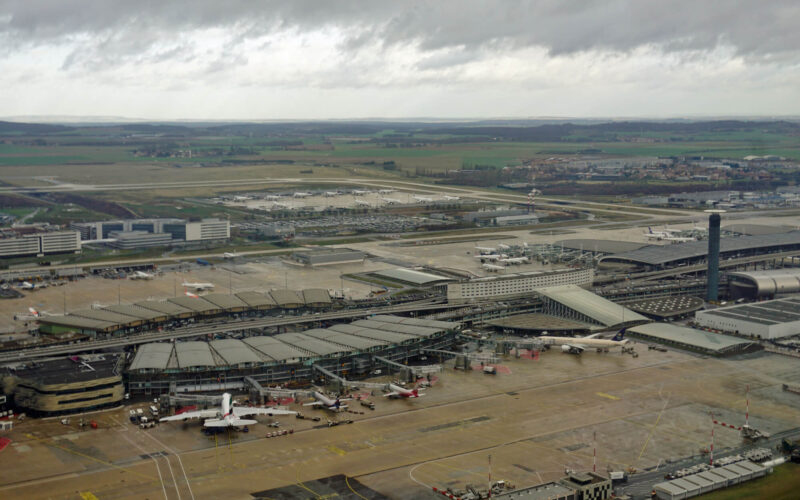A flight with 172 passengers came within 6 feet (1.8 meters) of hitting the ground while on approach to Paris Charles de Gaulle (CDG), according to a report by French investigators.
The Airbus A320, registration 9H-EMU and operated by wet lease specialist Airhub, was coming in to land at CDG on a flight from Stockholm Arlanda at approximately 11:40 UTC on May 23, 2022 when the near-collision occurred due to an incorrect altimeter setting.
The controller twice gave the crew an incorrect QNH setting of 1011, instead of 1001, with the mistake also not being spotted by the crew, and as a result the approach was flown 280 feet lower than it should have been.
The preliminary report, published on July 11, 2022, details several missed opportunities to correct the incorrect altimeter setting, including after Minimum Safe Altitude Warning (MSAW) warnings were generated for controllers and when the aircraft was on its second approach to CDG. Investigators therefore made several safety recommendations in light of the seriousness of the incident.
“During this serious incident, the MSAW was triggered on both approaches and the standard MSAW phraseology was not applied by the controllers. In particular, the crew were not instructed to check their altitude nor were they given the QNH,” the report stated.
The investigators recommended that Paris Charles de Gaulle air traffic services be made aware of how critical the correct QNH setting is for the type of RNP approach that was being carried out on the incident flight, the importance of confirming correct read-back of information and the correct phraseology and actions in the event of an MSAW warning being triggered.
For Airhub, the BEA recommends that crews are made aware of the importance of the correct QNH setting for such RNP approaches and implement a procedure to cross-check QNH information with another source.
Airhub Airlines, a subsidiary of the Lithuanian charter company GetJet Airlines, is a Malta-based airline specializing in ACMI flights. It operates an Airbus-only fleet of 3 A320, 3 A330, and 3 A340 aircraft, according to planespotters.net data.

Horizontal flight path of 9H-EMU. Credit: BEA
What happened?
The flight, which was being operated on behalf of Norwegian Air Shuttle, was on an RNP approach to runway 27 at CDG with LNAV/VNAV minima. This type of approach relies on the correct QNH setting being applied by crews because the aircraft will take its altitude information from the barometric altitude systems.
According to the preliminary report from the BEA, air traffic controllers received a ground Minimum Safe Altitude Warning at 11:41:32, when the aircraft was at an indicated altitude (Editor note: height above sea level) of 617 ft on the correct QNH of 1001, or 200 feet above the ground according to the radio altimeter, at 1.53 nautical miles from the runway threshold. With a QNH setting of 1011, the crew would have seen an indicated altitude of 891 ft. CDG is 392 ft above sea level.
Nine seconds later, at 1.2 nm from the runway, the crew passed the decision altitude of 802 ft as per the incorrect 1011 QNH setting. Because they could not see the runway, the crew opted to go around. However, on the correct QNH setting of 1001, the altitude was 537ft, and the radio altimeter showed the aircraft was 122 ft above the ground.
At 11:41:47, 15 seconds after the warning was received by ATC and while the controller was calling the aircraft, the autopilot was disconnected, and the captain pitched the aircraft up. Three seconds later and when still 0.8 nm from the runway, the aircraft reached its lowest point above the ground, at just 6 ft according to the radio altimeter.
 Profile of flight 9H-EMU. Credit: BEA
Profile of flight 9H-EMU. Credit: BEA
No terrain warning was recorded during the approach according to the BEA report and the crew stated they did not hear any radio altimeter callouts apart from 2500 and 1000 ft. Typically there are automated call outs at 500 ft and then starting from 50 ft above the ground. Crews also stated they did not hear the call from controllers reporting that they had received a warning that the aircraft was close to the ground.
As per procedure after an MSAW has been triggered, controllers should immediately advise the flight crew that a terrain alert has been generated, instruct the flight crew to immediately check their flight level or altitude, and give them the QNH.
On the second approach for landing, the faulty QNH setting was not corrected, and the aircraft was again 280 ft lower than it should have been. Another MSAW was generated when the aircraft was 3.1 nm from the runway at an indicated altitude of 1,403 ft on QNH 1011 (but 1,131 ft QNH 1001, 842 ft per the radio altimeter).
When called by the controller, the crew said they did not understand why the message had been received but that they were visual with the runway. However, runway PAPI lights indicated to the crew that they were lower than they should be, so they corrected the approach and landed safely.
In response to a query from AeroTime, Norwegian said it no longer has a contract with Airhub. “The initial contract with the company expired in June and no new agreement has been made,” a spokesperson said in an emailed comment to AeroTime.
UPDATE 26-09-2019, 09:44 (UTC +3): A comment from Norwegian was added.

